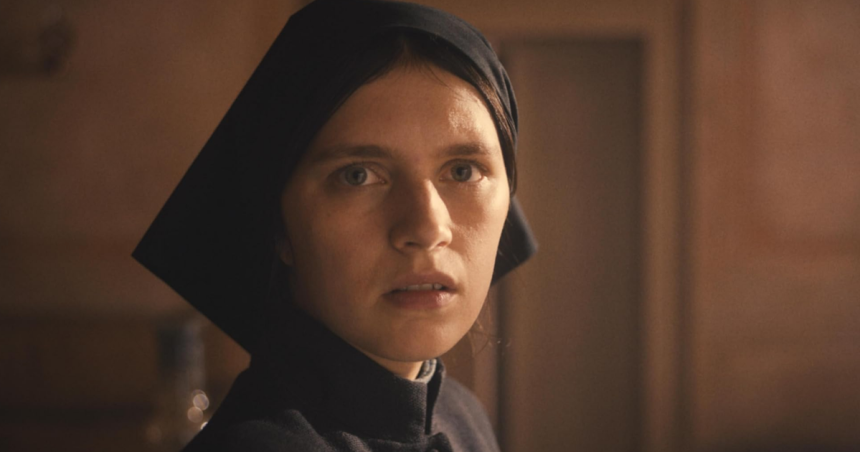Nell Tiger Free in The First Omen.
Photo: 20th Century Fox
At some point, we should probably have a conversation about how our culture has now given us, within the span of two weeks, two separate horror movies in which young American nuns arrive in Italy only to discover a sinister plan by a demonic faction of the Catholic Church to impregnate women — with a biological heir to Jesus Christ in Immaculate and, now, with the Antichrist in The First Omen. And no, I’m not really giving anything away about The First Omen, a prequel to Richard Donner’s Gregory Peck–starring 1976 classic, The Omen, about an American couple who discover that their son, whom they secretly adopted in Rome, is the child of Satan. (It could also be a prequel to the now-forgotten Liev Schreiber–starring 2006 remake of that film, I suppose, but The First Omen specifically references the Gregory Peck version, which until now was probably the only good Omen movie.)
“The stuff you see in horror films is not sui generis,” the great Wes Craven told me back in 2007. He was speaking at the time about how the popularity of the so-called torture-porn genre and the resurgence of gore was linked to the shocking images coming out of the forever wars in Iraq and Afghanistan. “This is a unique time in American history, where the government has admitted to torturing people,” he said. “The culture cannot help but reflect that atmosphere.” In other words, why should anyone have been surprised that the horror genre, already a psychological barometer of American society, began giving us images of torture right around the time the real world became filled with such images?
So why should anyone be surprised that suddenly, in the wake of the Supreme Court’s overturning of Roe v. Wade, as state after state attempts to enact religious laws depriving women of bodily agency, America is getting horror movies about people forced into monstrous births by religious institutions worried about their growing irrelevance? Whether it’s from a direct desire to be topical or a subconscious need to make our anxieties tangible, horror throws our world back at us.
The First Omen, directed by Arkasha Stevenson from a screenplay by herself, Keith Thomas, and Tim Smith, even makes a point of incorporating what’s happening in the society at large into its genre tale of creepy occurrences behind cloistered walls. In this case, the year is 1971, and the city of Rome has been seized by protests. Driving through the city, young novitiate Margaret Daino (Nell Tiger Free) asks her mentor, Cardinal Lawrence (Bill Nighy), about the turmoil. “For the workers, it’s about conditions and wages,” he replies. “For the students, it’s a rejection of authority.” He goes on to add that the Church is among those institutions in which these young people have lost trust and faith.
The film will go on to cut between the chaos in the streets and the chaos in Margaret’s mind. She’s always been beset by ghastly, unnatural visions, we’re told, and she becomes intrigued by Carlita Skianna (Nicole Sorace), one of the girls at the orphanage where she serves. Carlita is quiet, and odd, and unable to play with others. The nuns often send her to “the Bad Room,” a sort of solitary confinement for unruly girls. Margaret sees something of herself in the girl and tries to forge a bond with her. When a rogue priest (Ralph Ineson) warns her that Carlita might well be marked with the sign of the Beast, and that she might have been bred by the Church specifically to give birth to the Anti-Christ, Margaret is in denial. We know that the priest is telling the truth not just because this is an Omen movie but also because we saw him receive this information in a gruesome opening scene featuring the never-not-unsettling Charles Dance.
Look, this is a ridiculous story. It will surely leave you with more questions than it answers, especially since it has to both feed into the existing Omen and set up its own sequel. (Fox, acquired and gutted by Disney a few years ago, could use an active horror franchise.) But like the best studio horror directors, Stevenson understands that we’re not here for logic. The First Omen is soaked in style and mood with images that are both textured and shocking and that tap into tantalizingly visceral fears. Black veils wrapped around agonized faces. Monstrous figures lurking behind closed curtains. Grimy claws pawing at delicate female flesh. Drawings on walls that whisper dark nothings. Black habits hung on hooks that come to life with a burst of wind and a queasy glance. If horror is all about loss of control, about feelings of helplessness conjured in the audience to reflect the helplessness of the characters, then this is a true horror film.
Immaculate and The First Omen both borrow — musically, visually, atmospherically — from Italian horror and giallo. Even the performance styles are more heightened than in the typical genre flick; the actors in these movies have clearly been encouraged to go wide-eyed and loud. Despite the silliness on display, these movies work as expressive, expressionistic dream journeys. They have their share of momentary scares, but they’re at their best when working a deeper, more lasting sense of terror, logic and character development be damned.











